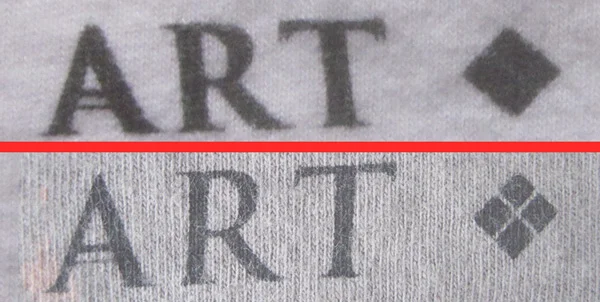We sometimes get the question, "why do you have a 12 shirt minimum?" Threds has a minimum of 12 garments for screen printing orders because 12 items is the least number of garments that can be efficiently screen printed. With time it takes to prep the artwork, burn in the screens and set up the press, producing under 12 shirts would make the price per shirt astronomical.
Enter Direct to Garment. The industries answer to cheap, affordable one-offs. Or is it really what its cracked up to be? I like to think of Dad’s advice on this one: Products can be cheap, quick, and quality— but they can’t be all three of those things.
What is Direct to Garment (DTG) printing?
Technological advancements have made DTG more popular in recent years, and DTG fans will tell you that they are able to replicate artwork and designs with a high level of detail. But that’s where the devil is, isn’t it?
"Well, why don't you print direct to garment?"
Direct to Garment (DTG) printers offer lots of versatility, but they not up to par with the quality, as illustrated below, you have come to expect from Threds. We only produce the highest quality prints and cannot offer anything less than the best to our customers. But that’s just one reason. We’ve assembled a list below of all the reasons we chose not to use Direct to Garment printing.
The top photo is a print using a direct to garment machine. The art is blurry and the negative spaces fill in during the printing process. The screen printed version below creates a crisper and cleaner print that retains a high level of detail.
Top Reasons NOT to use Direct to Garment Printing.
Quality. We mentioned this already. But it’s worth repeating. Did we mention quality?
Fade. If you’ve witnessed the magic of a DTG machine, you know it suspiciously looks a lot like that desk jet printer you used back when computers only came in beige or tan, or…what was that color? As such, you probably know what happens to ink when you inadvertently set your coffee on it or a document gets rained on. Now imagine your DTG Tee after a few washes. You get the idea. While many DTG printers will tell you that it all depends on how the application is carried out, we will tell you that we would take that challenge any day of the week.
Maintenance. Ever own a luxury car? Everything is great until it isn’t. Repair bills can add up quickly and if your the type of person who doesn’t mind a lighter wallet then all is well-and-good. But if your car breaks down you don’t pass the bill on to your employer because you were on your way to work. DTG machines aren’t exactly known for their reliability and businesses have to make the cost up somehow. Hmm…I wonder how they might do that.
To give an example, DTG machines use print heads, just like your old computer printer. Remember what happens if the ink dried out from sitting too long, or the job you printed used a ton of color? The heads become clogged and useless. Then you had to head over to the office supply store, and buy new cartridges and so-on and so-forth. If your DTG machine has clogged heads and you don’t have the part on hand, you’re stuck waiting for a new one.
It’s not really a screen printing problem but, if screens become too clogged, we print a new screen to replace it and get back to work. We wash out the old one, make sure the frame and silks are up to par, and reintroduce it back into the cycle.
There’s a significant difference between down time, and a bad time.
White Inks. Ask a DTG printer about white inks and watch their reaction. Industry leaders will tell their clients that the DTG problems of the past have been solved by newer technology and new methods. However, that still requires business to invest and train people on those new technologies and methods. Sounds like another checkbook-buster. Screen printing doesn’t rely on a limited palette to create a rainbow. It’s a little simpler and more straightforward. With screen printing, if you are looking to replicate an image, the same four-color palette can be used with extra colors added to make the image really stand out. The process adds another level of control that DTG simply doesn’t have.
The Blame Game. Everyone knows how its played and some DTG providers aren’t shy about telling owners the reasons they think their product isn’t selling. While sales and marketing are important parts of a business (and they’re very important), they aren’t everything. It’s an issue that could be argued for days. So the next time you see a door-to-door vacuum cleaner salesman, ask them what they think.
Personally, we don’t dump truckloads of money or investment into marketing.
For some unfathomable reason, we’ve gained hundreds and thousands of customers over the years just by word-of-mouth alone. Is it because of our excellent customer service? Well...yes, probably. Is it that our customers love our knowledgeable sales staff? That’s certainly part of it. Is it our commitment to quality and a reputation for delivering an excellent product time and time again? Most Definitely.
We’d rather spend time serving our clients and community, than going back and forth with some sales rep about the warranty just because they want to keep their commission.
Want Excellent Service & Products?
Contact Threds today and let us know about your next apparel project. We’d love to hear from you!





